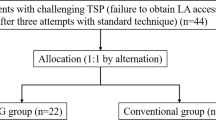Abstract
Purpose
A new type of visualized steerable sheath (Vizigo sheath; Biosense Webster Inc., Irvine, CA, USA) has been employed in clinical treatment. This study aimed to compare the effectiveness and safety of the Vizigo sheath to a fixed sheath (Swartz sheath; St. Jude Inc., St. Paul, MN, USA) for catheter ablation of paroxysmal atrial fibrillation (PAF).
Methods
We analyzed the procedural time, fluoroscopy time, contact force (CF), and initial pulmonary vein isolation (PVI) rate. After 6 months of follow-up, the success rate of ablation between the two groups was compared.
Results
Compared to the Swartz sheath, using the Vizigo sheath can significantly reduce the total procedural time and fluoroscopy time and increase the overall average CF, especially in the anterior left pulmonary vein (LPV), superior LPV, posterior right pulmonary vein (RPV), and superior RPV. The proportion of CF within a reasonable range in the Vizigo group was significantly higher than that in the Swartz group, especially in the anterior LPV, posterior RPV, and superior RPV. Besides, the left, right, and bilateral initial PVI rates in the Vizigo group were significantly higher.
Conclusions
The visualized steerable sheath for PAF catheter ablation not only reduced radiation exposure but also significantly improved CF and initial PVI rate, all of which indicated an increased rate of successful ablation.






Similar content being viewed by others
References
Jilek C, Ullah W. Pulmonary vein reconnections or substrate in the left atrium: what is the reason for atrial fibrillation recurrences? A dialogue on a pressing clinical situation. Europace. 2019;21(Supplement_1):i12–20.
Verma A, et al. Response of atrial fibrillation to pulmonary vein antrum isolation is directly related to resumption and delay of pulmonary vein conduction. Circulation. 2005;112(5):627–35.
Wieczorek M, Sassani K, Hoeltgen R. Comparison of pulmonary vein reconnection patterns after multielectrode phased radiofrequency- and cryoballoon ablation of atrial fibrillation. BMC Cardiovasc Disord. 2020;20(1):197.
Masuda M, et al. Steerable versus non-steerable sheaths during pulmonary vein isolation: impact of left atrial enlargement on the catheter-tissue contact force. J Interv Card Electrophysiol. 2016;47(1):99–107.
Calkins H, et al. 2017 HRS/EHRA/ECAS/APHRS/SOLAECE expert consensus statement on catheter and surgical ablation of atrial fibrillation. Europace. 2018;20(1):e1–160.
Hang F, et al. Study on the curative effect and safety of radiofrequency catheter ablation of paroxysmal atrial fibrillation via zero-fluoroscopy transseptal puncture under the dual guidance of electroanatomical mapping and intracardiac echocardiography. Cardiol Res Pract. 2021;2021:5561574.
Tahin T, et al. Implementation of a zero fluoroscopic workflow using a simplified intracardiac echocardiography guided method for catheter ablation of atrial fibrillation, including repeat procedures. BMC Cardiovasc Disord. 2021;21(1):407.
Antolic B, et al. Integrated 3D intracardiac ultrasound imaging with detailed pulmonary vein delineation guided fluoroless ablation of atrial fibrillation. Pacing Clin Electrophysiol. 2021;44(9):1487–96.
Casella M, et al. X-ray exposure in cardiac electrophysiology: a retrospective analysis in 8150 patients over 7 years of activity in a modern, large-volume laboratory. J Am Heart Assoc. 2018;7(11):e008233.
Faroux L, et al. Effect of modern dose-reduction technology on the exposure of interventional cardiologists to radiation in the catheterization laboratory. JACC Cardiovasc Interv. 2018;11(2):222–3.
Wartofsky LJH. Increasing world incidence of thyroid cancer: increased detection or higher radiation exposure? Hormones. 2010;9(2):103–8.
Neuzil P, et al. Electrical reconnection after pulmonary vein isolation is contingent on contact force during initial treatment: results from the EFFICAS I study. Circ Arrhythm Electrophysiol. 2013;6(2):327–33.
Park CI, et al. Mechanisms of pulmonary vein reconnection after radiofrequency ablation of atrial fibrillation: the deterministic role of contact force and interlesion distance. J Cardiovasc Electrophysiol. 2014;25(7):701–8.
Wakamatsu Y, et al. Impact of the combined use of intracardiac ultrasound and a steerable sheath visualized by a 3D mapping system on pulmonary vein isolation. Pacing Clin Electrophysiol. 2021;44(4):693–702.
Reddy VY, et al. The relationship between contact force and clinical outcome during radiofrequency catheter ablation of atrial fibrillation in the TOCCATA study. Heart Rhythm. 2012;9(11):1789–95.
Kuck KH, et al. A novel radiofrequency ablation catheter using contact force sensing: Toccata study. Heart Rhythm. 2012;9(1):18–23.
Efremidis M, et al. Early pulmonary vein reconnection as a predictor of left atrial ablation outcomes for paroxysmal atrial fibrillation. Europace. 2015;17(5):741–6.
Knowles BR, et al. 3-D visualization of acute RF ablation lesions using MRI for the simultaneous determination of the patterns of necrosis and edema. IEEE Trans Biomed Eng. 2010;57(6):1467–75.
Anter E, et al. Acute pulmonary vein reconnection is a predictor of atrial fibrillation recurrence following pulmonary vein isolation. J Intervent Card Electrophys. 2014;39(3):225–32.
Ninomiya Y, et al. First-pass isolation is associated with durability of pulmonary vein isolation and has impact on atrial fibrillation ablation outcomes. Circulation. 2019;140:2.
Acknowledgment
The research leading to these results received funding from 1·3·5 project for disciplines of excellence-Clinical Research Incubation Project, West China Hospital, Sichuan University.
Author information
Authors and Affiliations
Corresponding authors
Ethics declarations
Ethics approval
This study conformed to the principles of the 1964 Helsinki Declaration and was approved by the ethics committee of West China Hospital, Sichuan University. An informed consent form was obtained from all participants after the details of the study were explained.
Conflict of interest
The authors declare no competing interests.
Additional information
Publisher’s note
Springer Nature remains neutral with regard to jurisdictional claims in published maps and institutional affiliations.
Rights and permissions
About this article
Cite this article
Guo, R., Jia, R., Cen, Z. et al. Effects of the visualized steerable sheath applied to catheter ablation of paroxysmal atrial fibrillation. J Interv Card Electrophysiol 64, 511–518 (2022). https://doi.org/10.1007/s10840-021-01096-7
Received:
Accepted:
Published:
Issue Date:
DOI: https://doi.org/10.1007/s10840-021-01096-7




